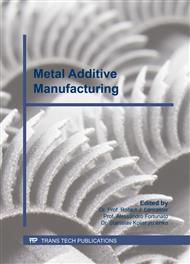p.1574
p.1579
p.1585
p.1591
p.1597
p.1603
p.1607
p.1613
p.1618
Microstructure and Fatigue Properties of TiAl with Unique Layered Microstructure Fabricated by Electron Beam Melting
Abstract:
The effect of a unique layered microstructure consisting of duplex-like region and equiaxed γ grains (γ bands) on the fatigue properties of Ti-48Al-2Cr-2Nb alloy bars fabricated by electron beam melting (EBM) at an angle (θ) of 90° between the building direction and cylinder (loading) axis was investigated focusing on the layered microstructure and test temperature. We found the room temperature (RT) fatigue strength of the alloy bars fabricated at θ = 90° is higher than that of the bars fabricated at θ = 0°. Moreover, it is comparable to that of the cast alloys with hot isostatic pressing (HIP) treatment in low-cycle fatigue life region, even without HIP treatment. The high fatigue strength of the bars at RT is attributed to the γ band, which acts as a resistance for crack propagation directed perpendicular to the γ band. On the other hand, the fatigue strength of the bars at θ = 90° is lower than that of the bars at θ = 0° in low-cycle fatigue life region at 1023 K. This is because the γ bands dose not act as a resistance for crack propagation at 1023 K. Although the bars at θ = 90° exhibits low fatigue strength in the region at 1023 K, that value is comparable to that of HIP-treated cast alloys due to the fine grain size, which is one of the features for the alloys fabricated by the EBM.
Info:
Periodical:
Pages:
1597-1602
Citation:
Online since:
December 2018
Keywords:
Price:
Сopyright:
© 2018 Trans Tech Publications Ltd. All Rights Reserved
Share:
Citation:



